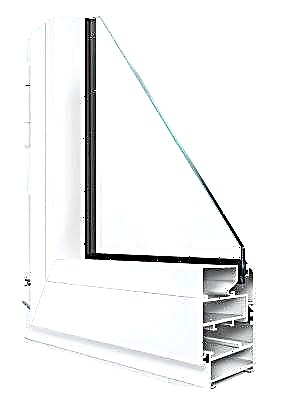In any room, a person should feel comfortable. Kitchen in this regard was no exception. This part of the apartment is spent most of the time.
Here all family members gather for a joint meal, and the housewives cook various sweets. In order for the kitchen to please the eye at the same time and at the same time be simple and functional, you need to carefully approach the selection of design and accessories for it. Tulle in the kitchen can play an important role in the design of the room.
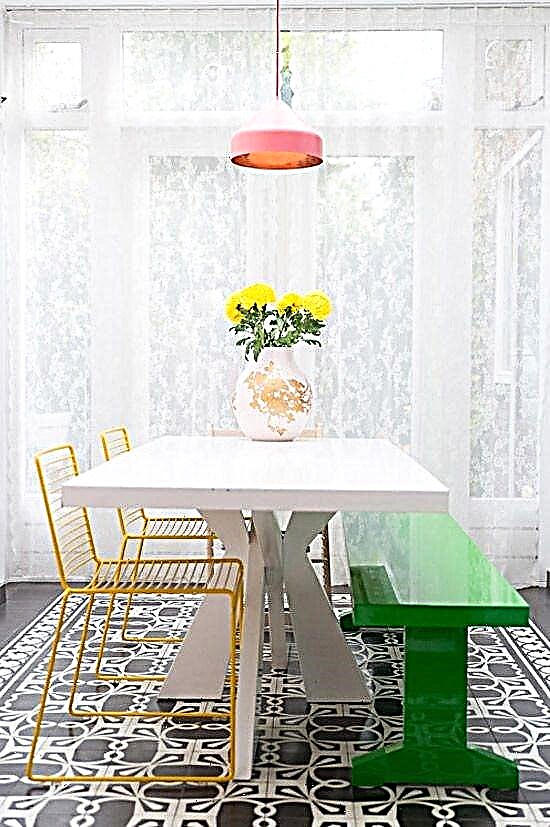
Tulle in the kitchen will add comfort to the interior
In the kitchen, it is important to maintain cleanliness and at the same time spend a little time on it. Therefore, it is better if the surfaces are easy to clean and be as low as possible. Decorations for the kitchen are better to choose simple. It can be several thematic paintings. Window decoration is tulle.
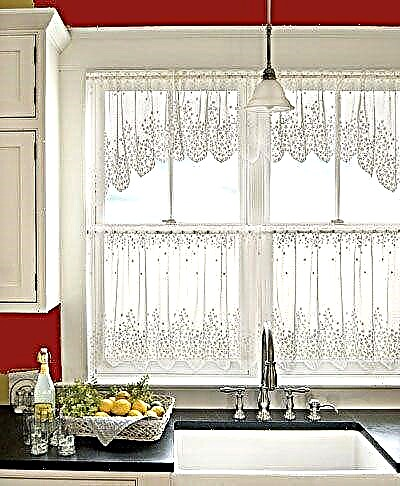
Light tulle in the kitchen
Tulle in the kitchen will be a great addition to the overall image of the room and give it a finished look.
Material for tulle
In the choice of "clothing for windows" the material from which it will be made plays an important role. The most common tulle for the kitchen is made of the following materials:
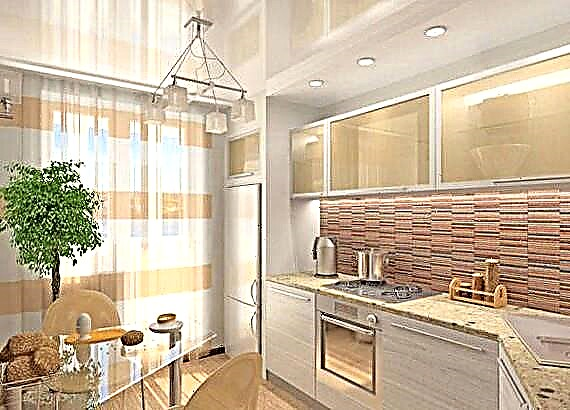
Organza kitchen tulle

Chiffon tulle in the kitchen
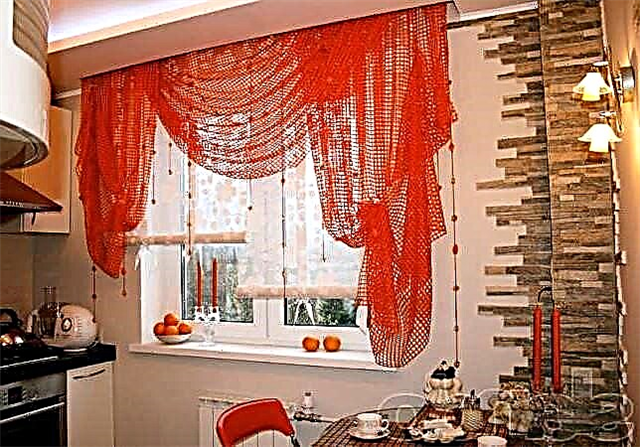
Bright tulle for the kitchen
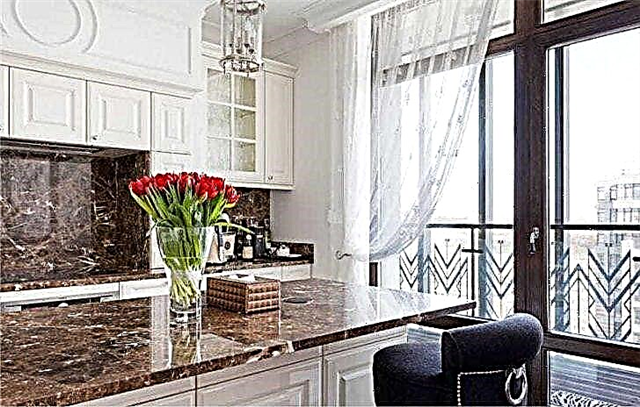
Veil for the kitchen window
For the manufacture of tulle, both natural and artificial fabrics are used. Tulle made from natural fabrics perfectly protects from sunlight and allows air to pass through. Faux tulle is more practical and less prone to warping and burnout. Now in design, multicomponent materials are widely used - this is a fabric that consists of several materials.
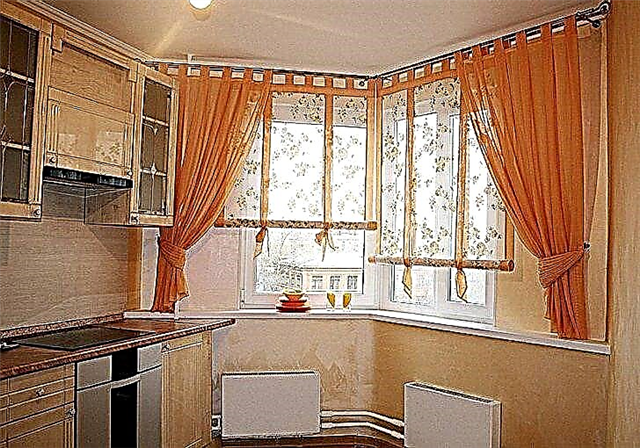
Combined tulle in the kitchen
The latest novelty from designers is a kitchen tulle with leather accents. They say that such a tulle is easy to care for, it is easy to clean and has high wear resistance.
Texture features
After choosing the material of the product, you need to pay attention to the structure of the tulle. To make a choice, you should take into account the location of the windows, the correspondence of the selected material for the tulle to the overall design of the room. For example, if the kitchen window faces the south side, it is better to give preference to a tulle made of dense and dark materials. Such a tulle will protect the room from sunlight and help keep cool in the room.
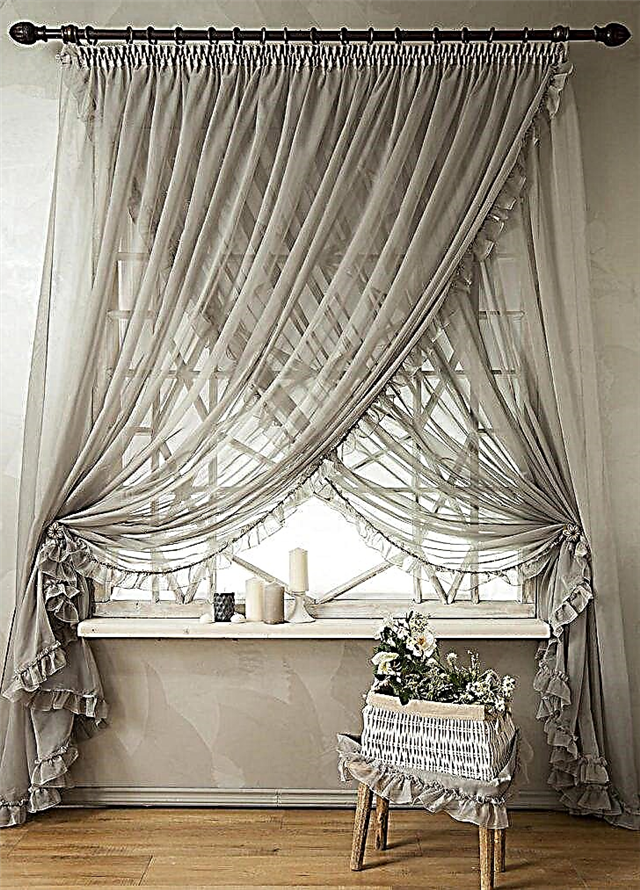
Dark tulle in the kitchen muffles a bright sunny color
According to the texture features, several types of material are distinguished:
- smooth,
- patterned or mesh,
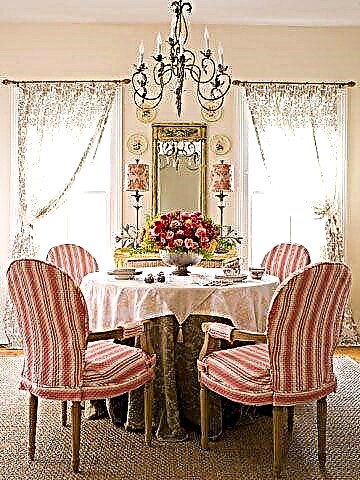
Tulle with a pattern for the kitchen in the style of Provence
- material with a smooth surface and a printed pattern,
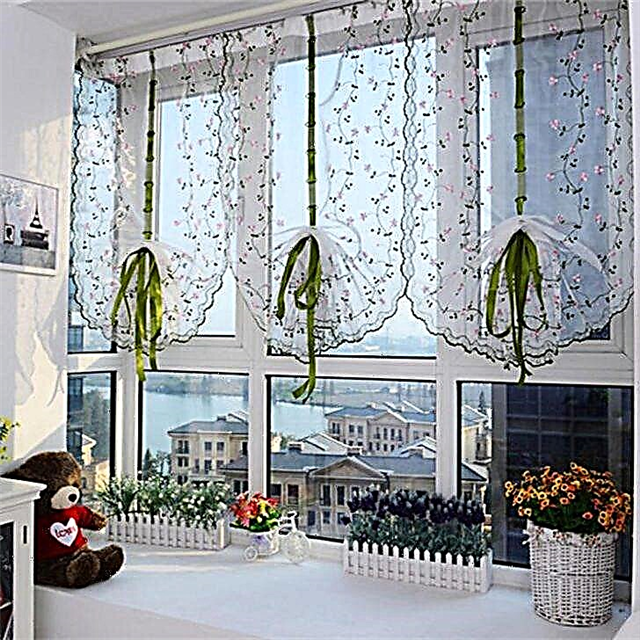
Embroidered Tulle
- Tulle with embroidered pattern.
Choice of tulle for the kitchen
When buying a tulle for the kitchen, you should remember that it should not only complement the image and give airiness to the room, but also perform the following functions:
1. Sunlight through the tulle should penetrate into the room in sufficient quantity, but at the same time keep cool in the room,
2. If possible, hide structural defects in the window or window opening,
3. Organically fit into the design of the room and complement it.
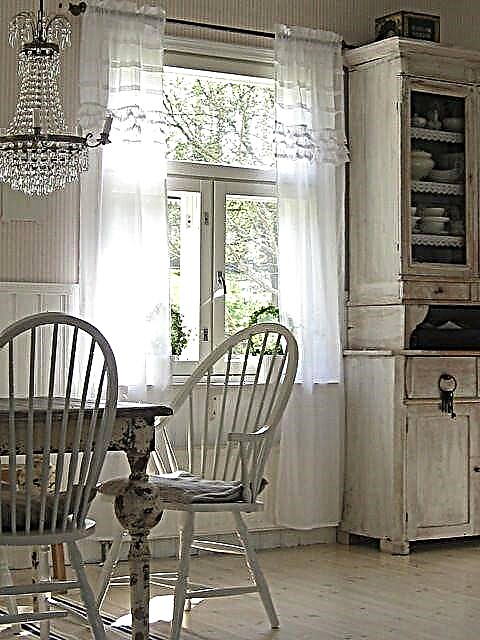
Tulle for the kitchen must match the style of the interior
Selection of tulle by style
Tulle is not well matched to the overall style of the kitchen can look ridiculous and spoil the entire appearance of the room. As already mentioned, tulle should complement the image, and not get out of it. So, which tulle is suitable for kitchens decorated in different styles?
Classic style
This style of design is most common. It is characterized by calm tones with slight bright accents. Designers recommend choosing a design for windows of soft colors, with or without a picture.
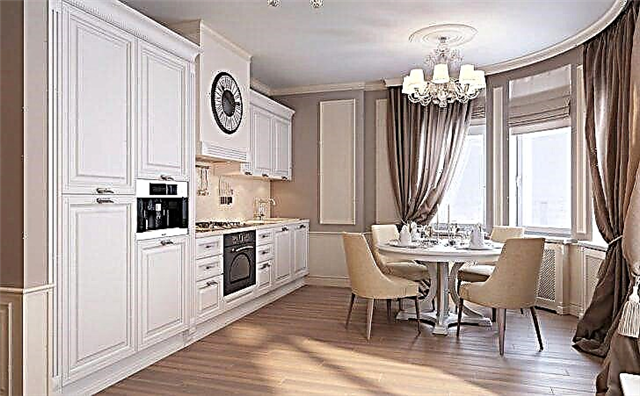
Plain tulle in a classic interior
If you prefer a tulle with a pattern, you should choose a material with a small and discreet pattern or pattern.
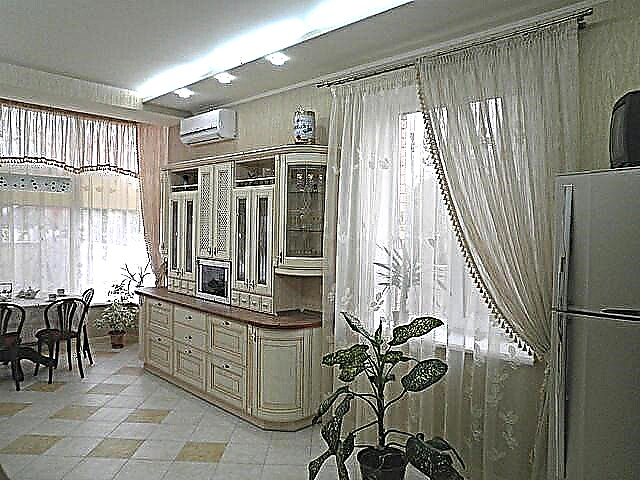
Tulle with a pattern for the kitchen in a classic style
Approximately the same recommendations apply to a country-style kitchen. Indeed, when decorating a room in this style, the most natural materials and colors are used.
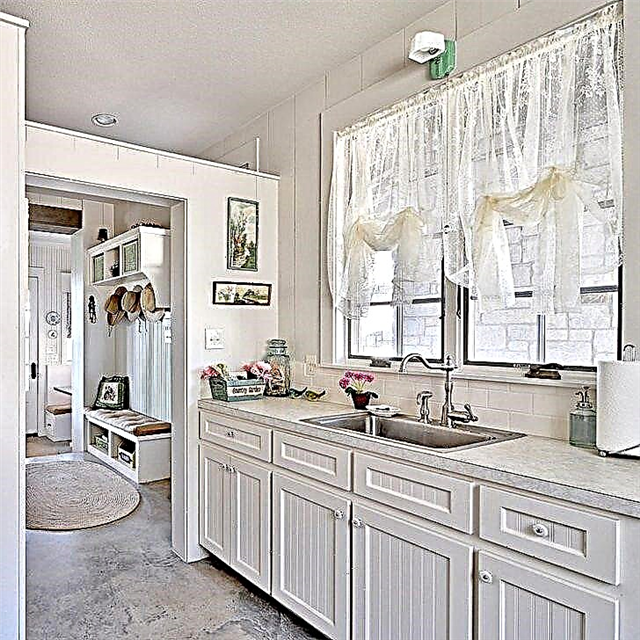
Country Style Tulle
Art Nouveau Kitchen
Tulle with a pattern printed on it in the form of straight or broken lines will organically fit into this style. A tulle with wide straight vertical lines is a good fit. They will be combined with the lines of the window opening and be one with it.
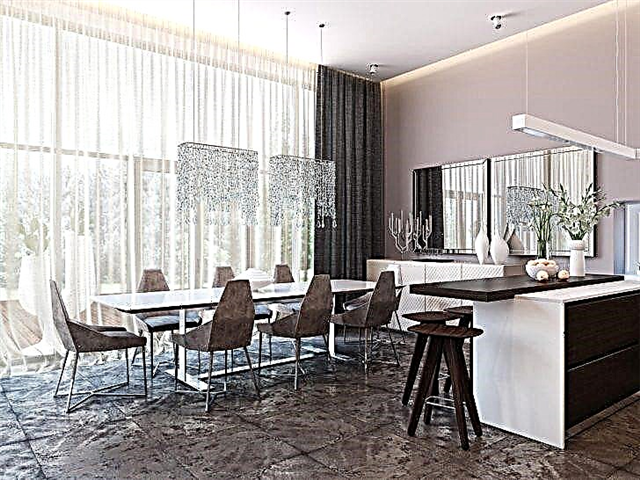
Tulle in the kitchen in modern style
Baroque or Rococo style
This style is successfully emphasized by tulle made of combined materials. It can combine mesh, organza, cotton or linen at the same time. To complement such a tulle for the kitchen, you can supplement with lace frills or decorate with embroidery. This combination of materials of different textures and densities will allow you to achieve an interesting game of sunlight in the room.
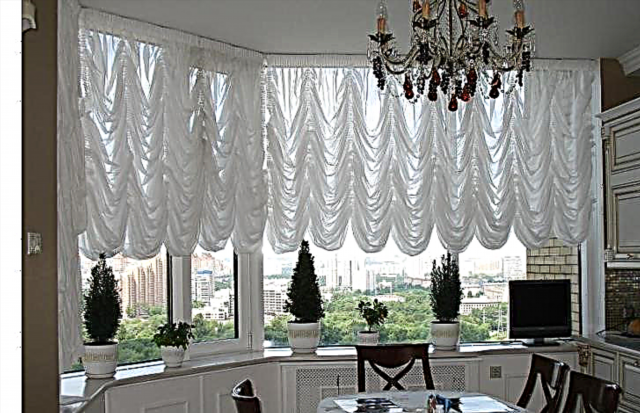
Baroque Tulle
Modern art deco
This style implies the presence of many brushes and folds in the design. Tulle decorated with a lambrequin fits perfectly into the interior of this style. The rim can be made of the material that the main fabric of tulle. It is enough to make it from a contrasting color and this will give a completely different look to the room. A thick rim or fabric curtains will look very rich. But this design is strictly contraindicated in small kitchens. In them, it will look heavy.
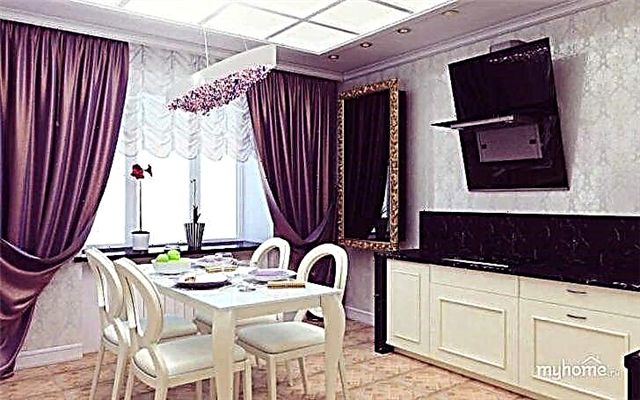
Tulle with many folds for the art deco style kitchen
Oriental style kitchen
To complement the overall image of such a kitchen, tulle interspersed with lurex thread, golden or silver tones is ideal. You can pick up a monophonic tulle of neutral colors, but decorate it with golden accessories. On a sunny day, they will reflect the sun and play with sunbeams.
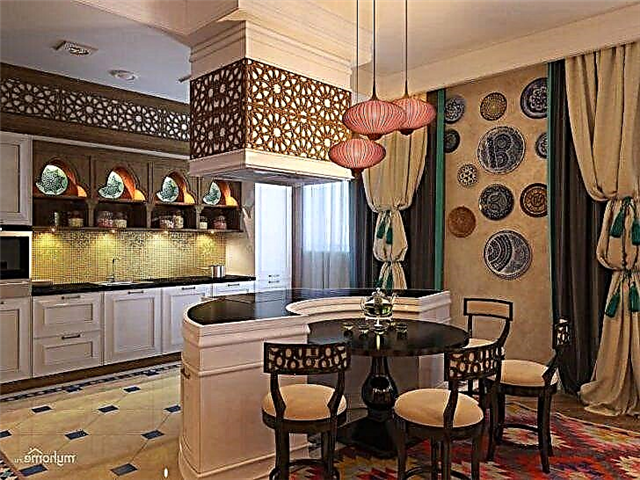
Colorful tulle for oriental style kitchen
As a universal solution, designers offer the use of filament tulle or bead tulle in the interior. They look spectacular in any kitchen and combine with any style. They also let in enough light and are an interesting accessory.

String tulle for the kitchen
Recently, among designers, tulle "noodles" is gaining popularity. It represents strips of cloth of various widths. Some of the stripes are decorated with beads or sequins. This tulle looks very impressive and fresh. It perfectly transmits sunlight and is easily cleaned of impurities. This tulle can be used in the design of windows not only in the kitchen, but also in the living room and bedroom.
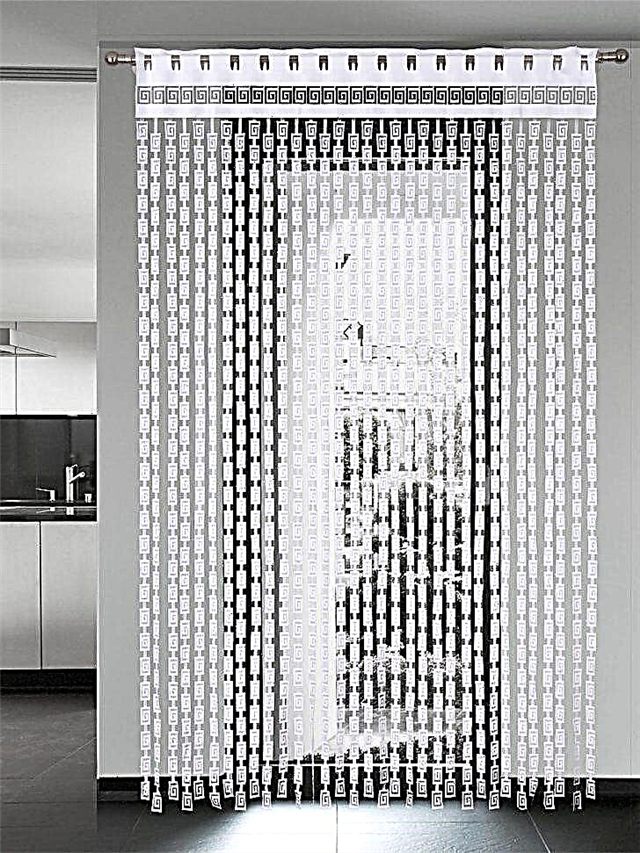
Tulle noodles will refresh the kitchen interior
Choice of tulle shape and length
When choosing a tulle in a room, people are usually guided by the color of the walls, flooring and color of furniture. Here rarely give vent to experiments with the length and shape of the tulle. But when choosing a design for kitchen windows, you can afford some liberties.
1. In the design, a combination of fabrics of different textures, color and density of fabric is allowed. A thin tulle framed by curtains made of darker and heavier fabric will look interesting. Firstly, it will allow you to adjust the amount of sunlight in the room, and secondly, it will create an amazing visual effect from such a combination.
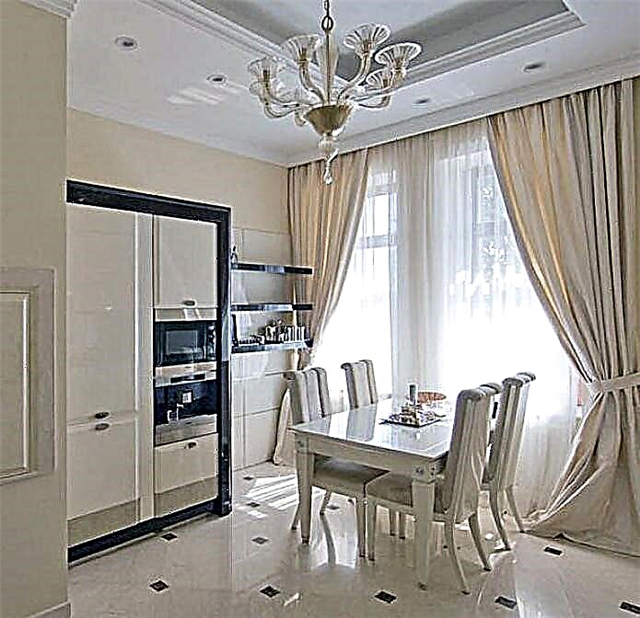
Combination of air tulle and canvas curtains
2. Tulle in combination with lambrequins and Roman blinds is more preferable in kitchens than tulle with curtains. The main advantage of such a tandem is less fat and dust that accumulates on the fabric and easier cleaning of the tulle. But this option is not suitable for a kitchen with a small area.
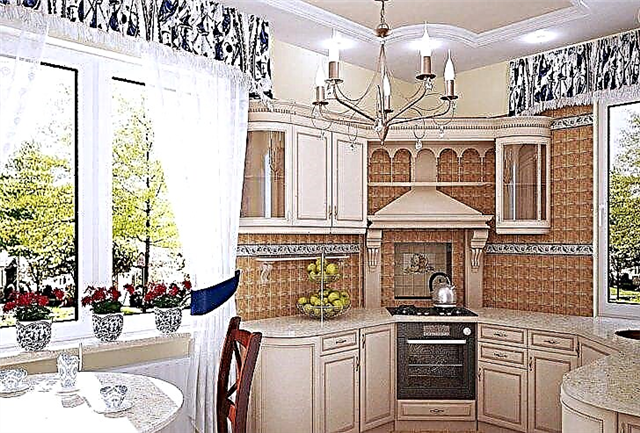
Tulle with pelmet for the kitchen
3. Most people prefer the average length of the tulle, to the windowsill or above it. But designers are advised not to be limited to such a choice and consider for window decoration in the kitchen with tulle to the floor.
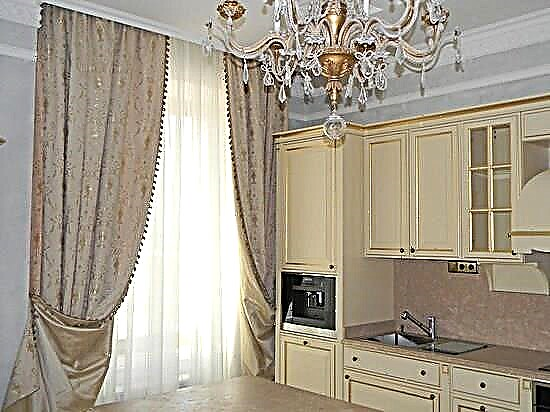
Tulle to the floor in the classic style kitchen
Advice from designers: using a long tulle to the floor complete with Roman curtains. Long curtains are good only if there is no kitchen furniture or stove near the window. If the kitchen furniture is near the window or adjoins it, it is better to choose a tulle long to the windowsill.

Short tulle for a small kitchen
As for the shape of the tulle, here you can give free rein to your imagination and come up with even the most bizarre shape, the main thing is that it fits well into the interior of the room.
Selection of colors
Many housewives use light-colored tulle, such as beige, peach, coffee or white, to design a window in the kitchen. And indeed a tulle of this color is ideal for any interior, visually enlarges the room and gives it lightness.
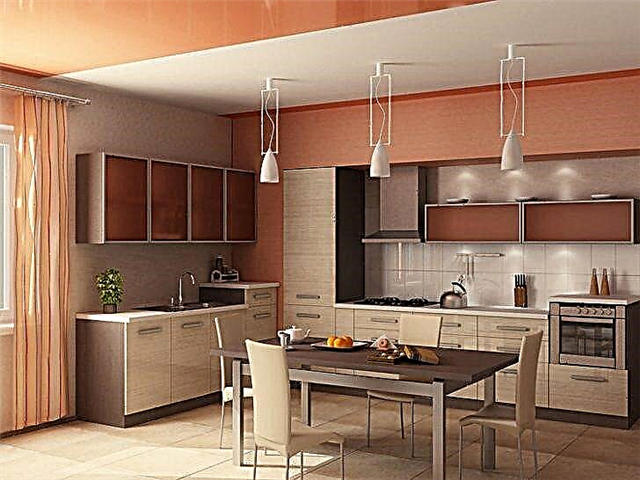
Peach tulle will visually increase the space
But you can try experimenting with colors and play on contrasts. Bright tulle will bring a touch of freshness and adventurism to the interior.
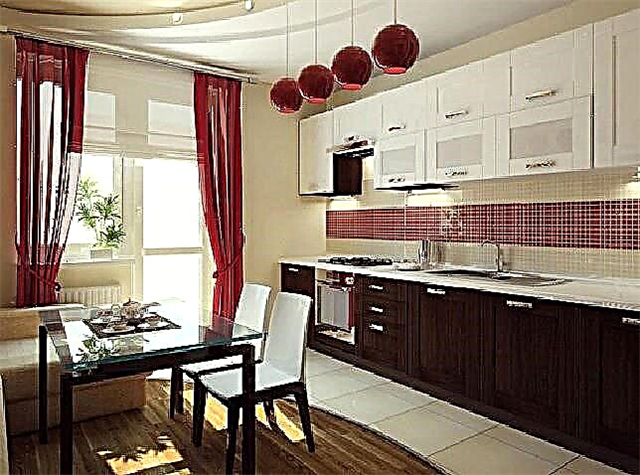
Contrast color tulle freshens the kitchen
In order to focus on the window opening, you should pay attention to the tulle of bright colors, for example, pink, purple, bright green or orange. More calm shades - green, yellow, will give peace and set in a positive mood.

Purple tulle in the kitchen
If the kitchen is the place where you want to relax and take a break from a hard day's work, then in the design of windows it is better to give preference to fabrics in cold colors: blue, light blue, mint.
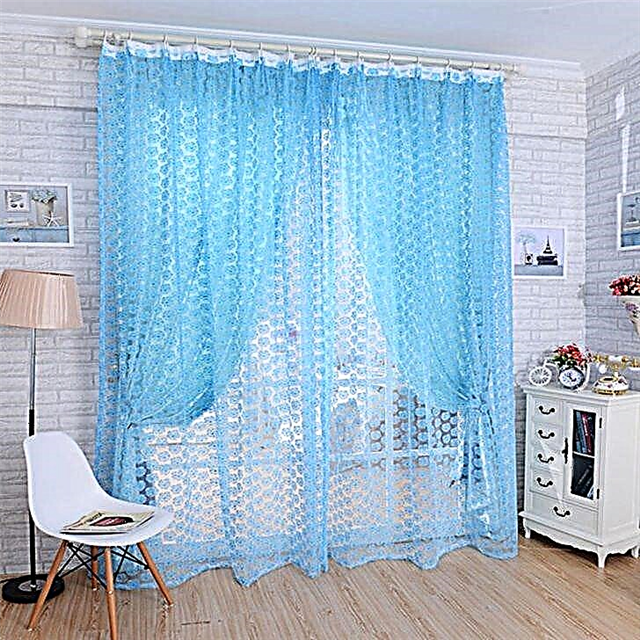
Blue Tulle Helps Create a Relaxing Environment
Many do not imagine the tulle in the kitchen in dark color. It is believed that dark gray, brown, chocolate or black tulle will look dark. In small kitchens this will really be the case. However, if the room is large, then the use of dark curtains will be appropriate for emphasis on details of the same color scheme or if the kitchen design is made in bright colors.
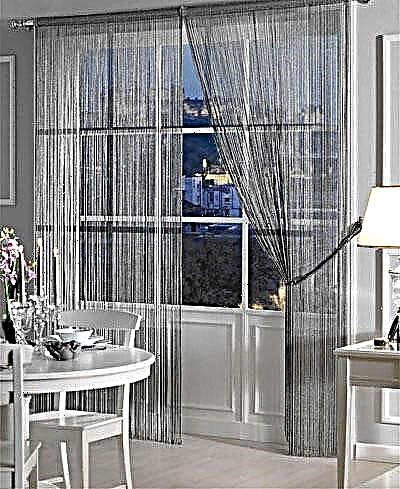
Gray tulle will be appropriate in a bright kitchen
But no matter what color of the tulle is chosen, it must correspond to any color used in the design of the kitchen. If several colors are combined in the design of windows, then it is necessary that one of them matches the color of furniture, walls or some interior details.
This year's popular color schemes
Designer's tip: in 2016, tulle of all shades of beige, mint and deep blue is especially popular.
The use of beige tulle in the kitchen makes it cozy and gives a special charm. They are much more practical than white curtains, but at the same time also organically fit into any interior. Especially designers are advised to draw beige shades on the tulle when designing a kitchen in a classic style.
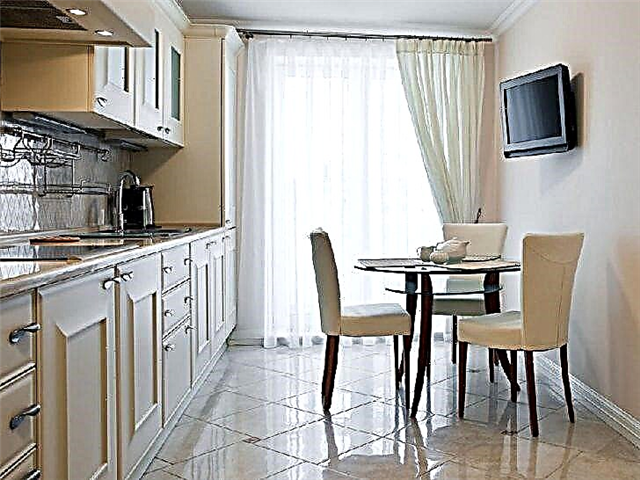
Beige tulle in the kitchen
The sandy shade of the material is also now at the top of popularity. It fits perfectly into the interior of the kitchen decorated in soft, pastel colors. The use of such colors in the interior energizes and get a positive attitude for the whole day.
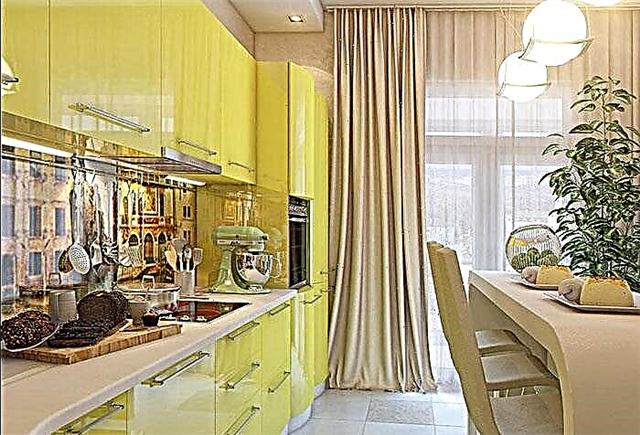
Sand-colored tulle in the interior
The feeling of spring freshness and purity will give the kitchen mint-colored curtains. Finding curtains of this color is not easy, but the effort will be worth it.
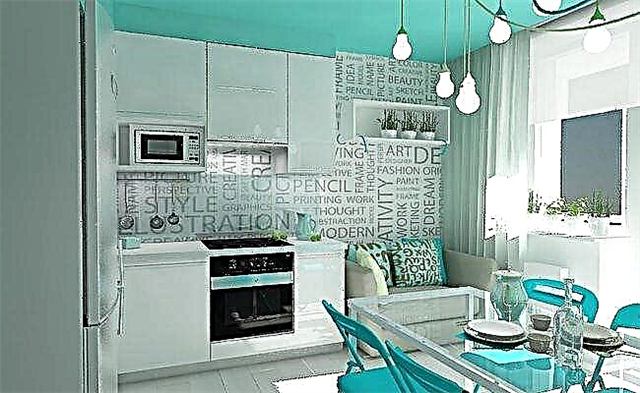
Mint color tulle gives a fresh feeling
Light blue shades - the perfect solution for the design of tulle in the interior made in a marine style. Such color schemes will look good and in the kitchen decorated in a modern style.
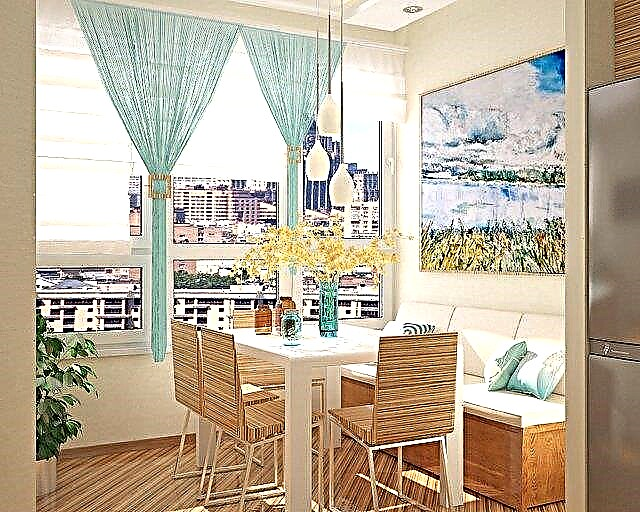
Nautical style kitchen with blue curtains
A fashionable color scheme, which is increasingly found in the design of windows in kitchen interiors, is almonds. As an emphasis on interior details, such curtains will not work, but in order to create a complete image in a classic or provincial kitchen, they will do just fine.
What types of curtains are relevant in 2016
Every season dictates something new. Fashionable trends in window design were no exception. This year, the following types of curtains are of particular relevance:
- Designer tulle. Now it’s fashionable to use creative and elegant curtains for window decoration. Using designer curtains in interior design, this does not mean paying a lot of money for them. You can independently develop their design and bring it to life. Such a tulle among others will highlight unusual accents or decoration, and then the most ordinary tulle turns into a design one.
Why do many housewives choose tulle for a window in the kitchen
- Durability. No material can be compared with tulle curtains in strength. Without losing color and texture for many years, the curtains can be altered, decorated with new elements, picked up - design solutions know no boundaries.
- Ease of care. The window in the kitchen, like the curtains, should be washed and cleaned approximately once a month. Even with the optimum hood, this part of the kitchen interior needs systematic care. Tulle, like no other material, is easy to wash. It is enough to soak the curtains, observing the technology of washing synthetic things, slightly stretch and rinse well. If there is no cotton or other natural threads in the thread filling of the tulle, it does not need to be ironed. Many housewives hang the pressed tulle right on the window. The material dries in half an hour, does not stretch and does not fold.
- Cheapness. The range of curtains for the kitchen window ranges from budget to very expensive. Tulle has a standard low price with the extraordinary beauty of the fabric. The structure of tulle weaving suggests that it is a light, airy material with a large number of open cells. Due to the structure of the fabric, tulle curtains have always been used as a rich decoration; this fabric can decorate any interior and hide possible room imperfections.
Organza
Organza tulle is made by tight weaving. The material is solid, but it passes air quite easily if weaving involves the use of natural silk.
 Despite the obvious simplicity of execution, this drapery looks very impressive.
Despite the obvious simplicity of execution, this drapery looks very impressive.
Organza made of synthetic threads is much cheaper and in appearance does not differ from silk. The only difference can be considered not so high hygroscopicity of the material.
For a kitchen window, organza tulle in white or pastel color will be a rich addition. By visually increasing the space, such a curtain will keep cool on a hot day.
Grid
The type of weaving mesh can be obtained from both natural (cotton, linen) and synthetic threads (viscose). Weaving is quite simple, as a result, the fabric resembles a small, or large mesh. Woven multi-colored threads allow you to choose both plain and multi-colored curtains.
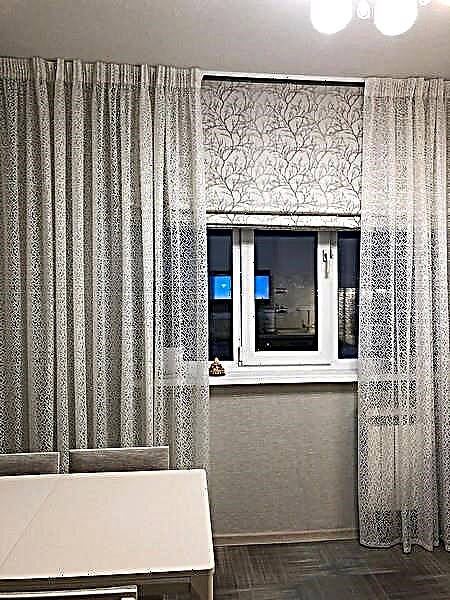 In such a curtain, the grid can be either large or small.
In such a curtain, the grid can be either large or small.
The advantage of synthetic tulle net is that the kitchen window will be securely closed from prying eyes, and the hostess will be able to control everything that happens on the street. The disadvantages of the material include the fact that dust accumulates quickly enough on the grid, but the ease of washing quickly removes this disadvantage.
Weaving veil
Tulle type veil can be used not only for the kitchen window, but also as the main curtain in the living room or bedroom. The fabric has a dense structure, although it is made from thin synthetic yarns.
The applied print makes the veil a very rich material, so this curtain does not require additions. Among the shortcomings of the material: the kitchen tulle from the veil requires ironing, since the fabric is subject to deformation regardless of whether it was used in natural or artificial threads.
Batiste Tulle
Extra-class cotton threads, when woven, form a smooth and thin structure. When embroidered with cambric tulle, when choosing a color scheme suitable for a particular interior, it will be able to create a special flavor and comfort in the kitchen. Batiste - the material is natural, after washing (quite simple - the material cannot be machine washed, bleached, boiled), ironing is required.
 Batiste tulles look very expensive in the interior.
Batiste tulles look very expensive in the interior.
Chiffon fabric
Chiffon tulle is structural, with a convex pattern, many colored threads or plain - a colorful option for a kitchen window. Even flowerpots with flowers fade against the backdrop of such a curtain. It is made of synthetically threads, it is easily erased, not ironed. The only difficulty can be sewing the necessary curtain, the material crumbles along the raw edges.
Jacquard weave
Embossed tulle is made of threads of various thicknesses with a variety of patterns. It is on jacquard tulles that fabulous gardens flourish and birds of paradise sing. The most expensive material, but it pays off with its durability. The jacquard curtain will last at least 40-50 years, without losing color and maintaining structure.
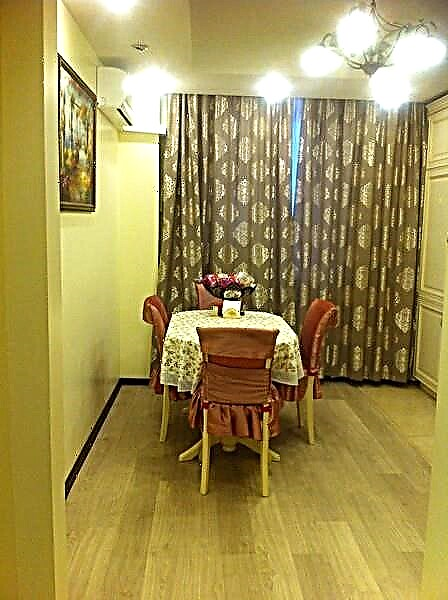 Tulle for the kitchen has extraordinary decorative features.
Tulle for the kitchen has extraordinary decorative features.
Short tulle
The method of decorating using a short curtain is quite practical. However, housewives should not forget about the rules of fire safety - Do not hang curtains that come in contact with the stove near the stove.
A short organza or veil tulle will fill the kitchen with ease and increase the space. By hanging a tulle with a wide window, and decorating the opening with folds, you can achieve a classic design.
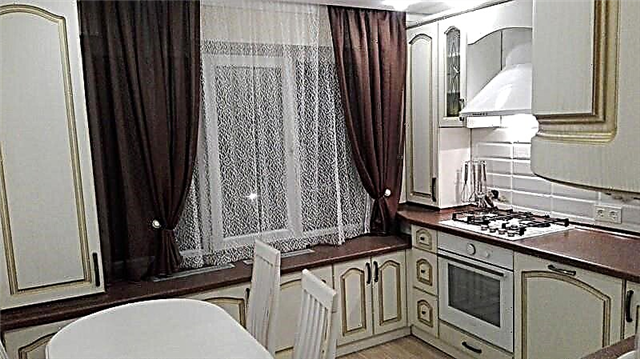 Curtains hanging on decorative hooks, as in the photo, harmoniously fit into this design.
Curtains hanging on decorative hooks, as in the photo, harmoniously fit into this design.
Decorating the bottom of the short tulle with a wide border in the color of the walls, and picking up the tulle along the edges, the Mediterranean version of the design is achieved.
Using this method of attaching tulle to the cornice, as wide loops sewn from the same material as the main curtains, they create a country style or a medieval European style of village housing.
Long tulle
A long tulle curtain on the floor is only suitable if the kitchen has a large working area. In small rooms to hang a long tulle is not practical and inappropriate. Even if the curtain will consist of two halves, so that access to the window is convenient, a long tulle will most often interfere with the hostess, and not please.
In large kitchens, where the space near the window is free, or there is a dining table, you can use jacquard tulle as an addition to the interior. A beautiful, juicy drawing and bright colors will always please the hostess, even if there are no more decorative elements in the kitchen.
Arched tulle
A curtain that opens a window but has hanging ends, a convenient and practical option for both small kitchens and large dining rooms.
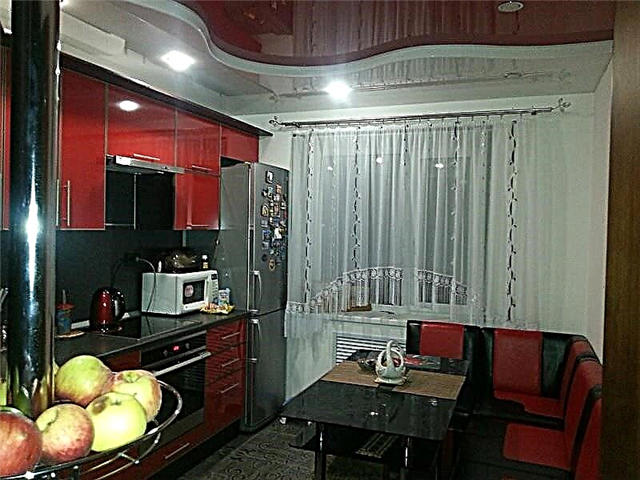 An arched curtain is a win-win option for windows facing the north side, where there is not enough sunlight.
An arched curtain is a win-win option for windows facing the north side, where there is not enough sunlight.
When decorating an interior in the Provence style, they often use a tulle arch with a wide decorative bead. As the main material they take a veil or a cambric without a bright pattern. The arch can be placed in the window opening as folds, and slightly wavy. The design of the curtain allows both to protect the kitchen from prying eyes, and to provide air access.
Half Tulle
A window curtain of two, three halves would be a good decor if, in addition to the window in the kitchen, there is a balcony door. Each element of the curtain can be selected from various materials, draping a window opening from tulle jacquard to chiffon and cambric.
With a combination of tulle with installed blinds, you can quickly decorate the interior in modern style. This option is used in those rooms that are located on the sunny side, and the hostess may experience stuffiness on a hot sunny day.
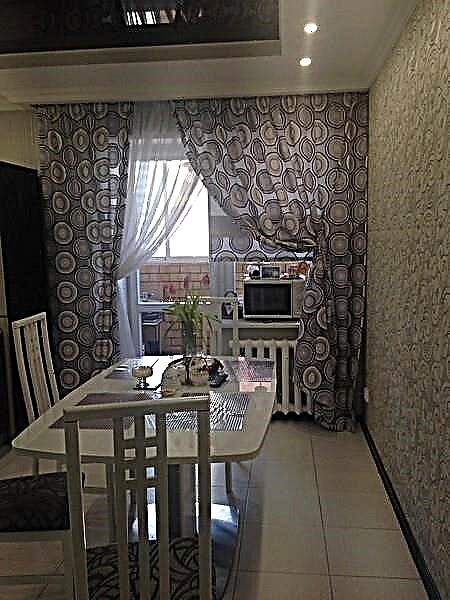 The color and texture of the material for sewing tulle can be completely diverse.
The color and texture of the material for sewing tulle can be completely diverse.
If preference is given to oriental style, instead of blinds, curtains are used as an addition. But a window design with curtains will be appropriate only in large kitchens, with sufficient air intake.
Tulle on eyelets
Eyelets or metal rings along the edges of the tulle make it easy to hang the material on the window. By hiding the grommets in the kitchen ledge or vice versa, leaving them on top, you can achieve an exclusive design of the room.
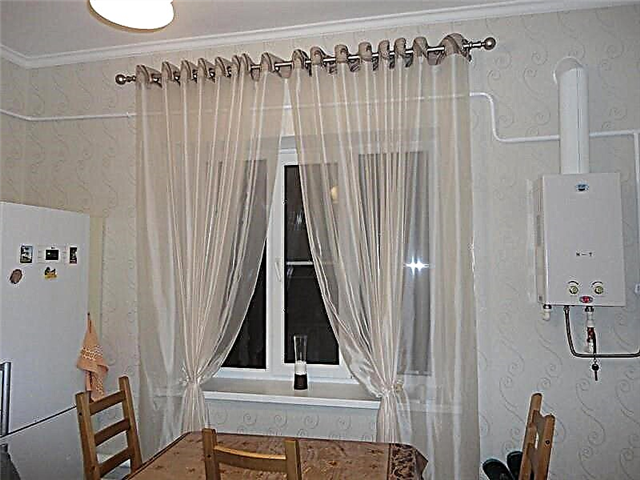 Eyelets - curtain fasteners in the form of metal, wooden or plastic rings, framing round holes in the upper part of the curtains.
Eyelets - curtain fasteners in the form of metal, wooden or plastic rings, framing round holes in the upper part of the curtains.
In addition to metal curtains, there are plastic eyelets on the curtain curtains and the edge of the curtains with a braided cord similar to a grommet. The main criterion for choosing the type of eyelet is the individual taste of the hostess and the overall interior of the kitchen.
There are several practical recommendations for choosing a metal eyelet:
- Tolerance to corrosion. The metal should be well crafted.
- The density of the insert. The ring should not have a sharp, cutting edge.
- Uniformity. Eyelets should be clearly located along the edge of the tulle.
The most beautiful are jacquard colored tulles on the grommets of yellow (gold) color. On rich fabric, these decorative elements look like precious metal.
Tulle curtain with lambrequin
French style involves lambrequin drapery. Lambrequin as a separate drapery over the entire width of the cornice is perfectly combined with tulle from any material. The main rule is that the lambrequin itself should be made of lightweight material, preferably in texture matching the main fabric.
In addition to a beautiful view, lambrequins hide the cornice - this is the practical side of using this drapery.
Lambrequins can be sewn directly to the curtain itself, can be hung separately. This addition is combined with a short, long tulle, a tulle of two halves.
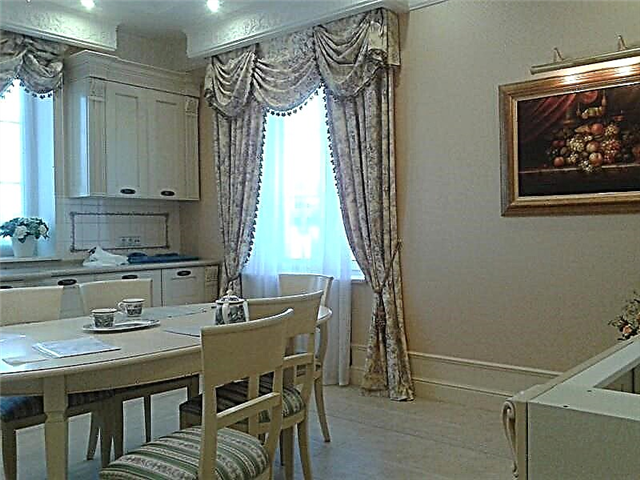 Lambrequin is a short static curtain that is hung out over the entire width of the cornice or window opening.
Lambrequin is a short static curtain that is hung out over the entire width of the cornice or window opening.
If the kitchen curtain is sewn in the form of an arch, it is not recommended to use a lambrequin by designers, it is clumsy and inappropriate. If the tulle is attached with grommets, then they themselves perform a decorative function, complementing the cornice with a lambert will not be aesthetically pleasing.
The assortment of tulle, decorative inserts, and decorating methods is so numerous that the mistresses are tempted to fit all styles and designs into one window opening.
You should not rush, each woman has her own unique interior, and finding it is quite simple, you just need not to be afraid to experiment.
Fabrics for kitchen curtains
The most popular synthetic fabrics used to decorate a kitchen room are the following:
As an additional decor, factory embroidery is often used. In the kitchen, a curtain with embroidered flowers or a light abstract ornament is very appropriate.
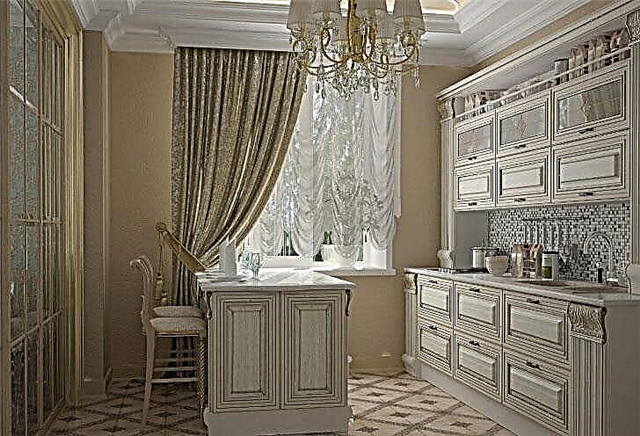
The modern design of the curtains in the kitchen involves the use of textiles with fashionable prints. Of modern curtain decoration technologies, a devore (etching with chemical substances of patterns) or batik are also used. But the use of such fabrics in the kitchen is rarely allowed because of the high cost of the material.
Kiseya (filament, rope curtains) with all its transparency perfectly protects the window from prying eyes, but at the same time lets in fresh air and gives a feeling of lightness and weightlessness. In kitchens, a plain monochromatic muslin or one that imitates a rainbow looks attractive.
Practicality of kitchen curtains
Modern manufacturers of textile products offer a wide selection of fabrics designed specifically for use in the kitchen. These are factory impregnated dust and grease repellent materials. That is, using such curtains, you can be calm that it will not deteriorate from accidental contact with fat on the fabric, and after washing it will not lose its previous color scheme.
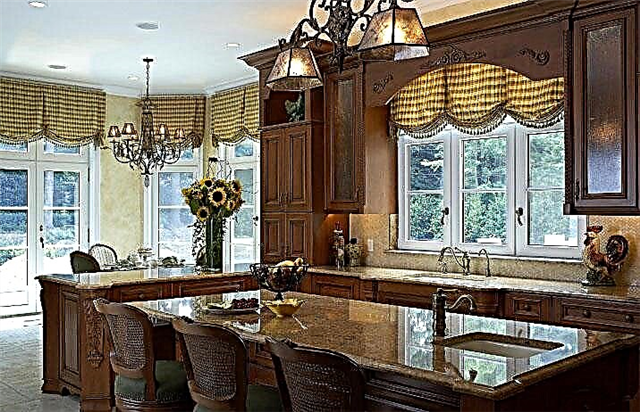
A popular option is a ready-made tulle in the kitchen in the form of muslin with impregnation. They are loved by consumers for their attractive design and practicality. Washing these blinds does not present any problems: the threads are placed in a warm soapy solution, rinsed with hands, rinse the soap under a directed stream of water and allow the product to dry in a semi-dry state directly on the cornice.
The use of curtains made of natural textiles on kitchen windows is acceptable (for example, when decorating a room in the Country or Provence style), but it is not considered practical, because the beautiful tulle in the kitchen is worn out with frequent washing, and greasy or dirty stains are problematic. In addition, during prolonged use in an environment with high humidity, harmful bacteria can settle on natural fibers, which is unacceptable in relation to the kitchen.
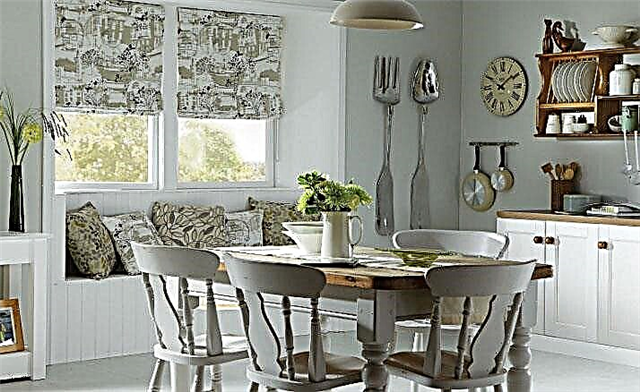
Ideal - synthetic tulle curtains for the kitchen.
Synthetic benefits
Visually synthetic curtains are in no way inferior to natural. In the production process, the following raw materials are used:
- polyester fibers (lavsan, dacron),
- polyacrylonitrile fibers (orlon, nitron),
- polyamide fiber.
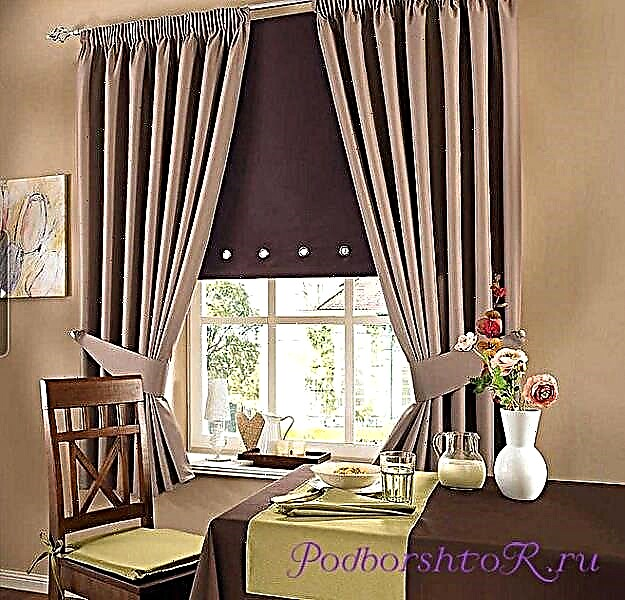
Synthetic Model
A decorative fabric made using such raw materials is distinguished by a mass of the following advantages:
- Resistance to damage, durability.
- Low susceptibility to high temperatures.
- Environmental friendliness.
- The absence of elements that can cause allergic reactions or release substances harmful to human health into the atmosphere.
- Resistance to moisture.
- Immunity to the spread of harmful microorganisms (mold, fungi) on the surface.
- Durability of operation.
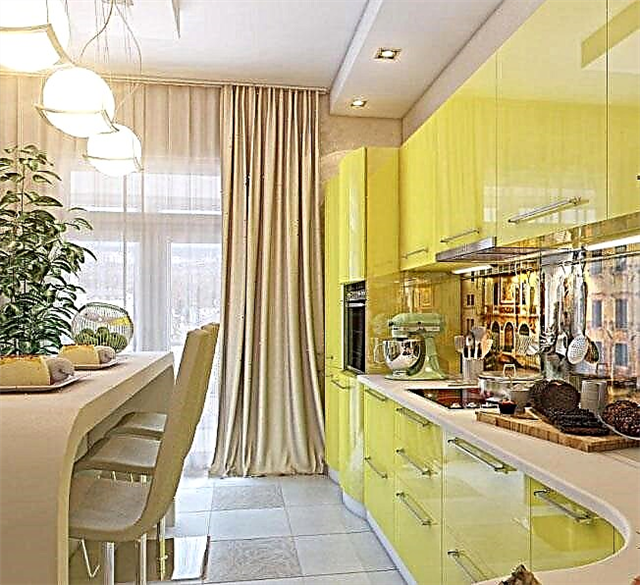
Tip: if the kitchen windows face the sunny side, it is not recommended to decorate them with bright fabrics that enhance the warm effect. Such an interior is difficult to tolerate on hot summer days. But the tulle in the kitchen in yellow and orange shades (if there are similar accessories in the kitchen interior) is appropriate for decorating a window opening located on the north side.

Types of tulle in the kitchen
When choosing a tulle for a kitchen, they suggest its compatibility with many kitchen attributes and accessories. Often used companion fabrics, that is, those that are aesthetically combined with each other. Let's say there is a beige tablecloth. If using a similar fabric for curtains seems a boring option, apply a similar tonality canvas, but with a pattern that matches the style.
Tip: in the case of a small kitchen room, designers do not recommend using more than 2 colors, only their shades are acceptable.
Arched curtains
Arched curtains are widely used in decorating window openings made in the form of an arch. Often such techniques are used in the construction of private houses or country cottages.

Curtains for arched windows are hung in several ways:
- on a flat ledge above an arch,
- overlapping, creating heavy creases,
- in the form of an arch.
Also popular was the method of decorating the arched opening with rope curtains.
If the ceilings in the kitchen are high, then the arch is decorated with lambrequins that can visually expand the space and give the necessary notes of comfort.
But even in a standard apartment with ordinary rectangular windows, you can beat the visualization of the arch. Using curtains of this design they create an imitation of an arched window: it is considered unusual and stylish, gives the room charm and hones the aesthetics of the decor.
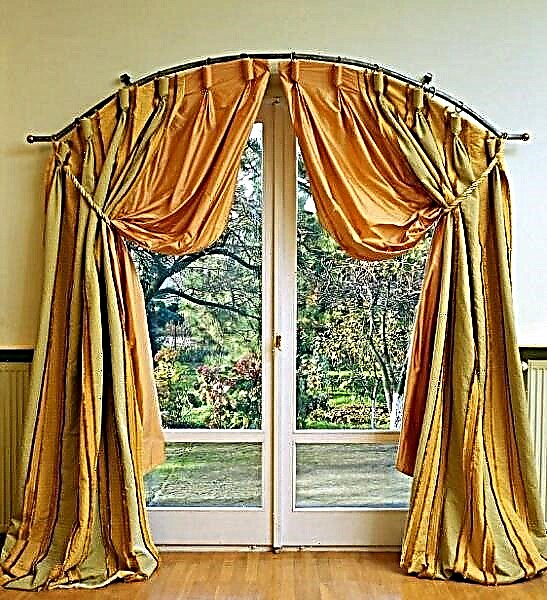
Curtains create 2 types of arches:
Tulle curtains with an arch to the kitchen create an unusual geometry of the kitchen, soften the corners, as a result of which the atmosphere is more comfortable.
Looks nice option with arched curtains, intercepted in the corners by ribbons, pickups.
It is better that the curtain in the kitchen is not long, because this room involves constant cleaning and mopping.
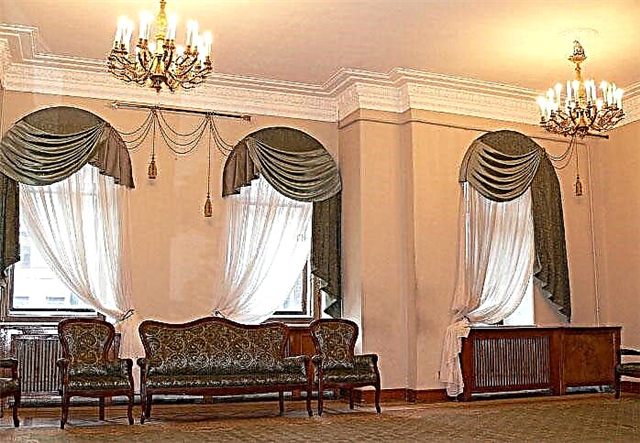
Curtains on grommets
Tulle to the kitchen on the grommets differs from other types in that due to the round elements beautiful uniform folds are created.
The grommets are attached to the upper part of the canvas, they are strung on a cornice, resulting in a finished decor of a window opening with a neatly draped fabric.
Eyelets are made of metal and plastic; they can be located close to each other or at large distances. The heavier the tulle and the smaller the distance between the grommets, the larger the folds will turn out, and vice versa.
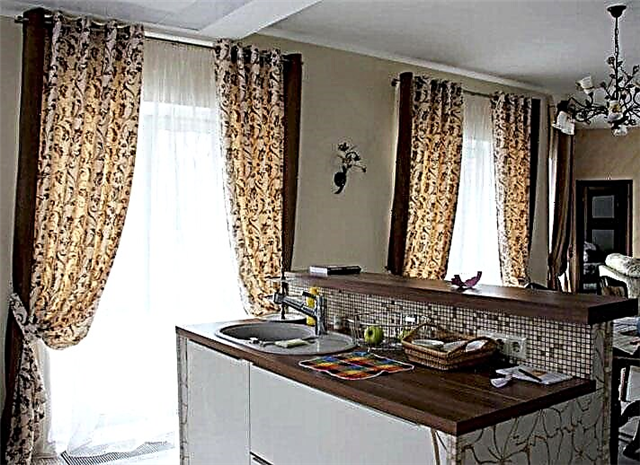
For a large room
Spacious kitchen allows you to use a lot of decorative techniques. Here, any, even heavy and expensive, curtains are appropriate. If the window is far from the stove, you can choose long curtains. The closer the fabric is to the source of pollution, the shorter it is made, and ideally they are tied to the sides.
Classically decorated kitchen room allows a lot of decor options. A prerequisite is a harmonious color combination.
It is important to adhere to the style in which the kitchen is decorated. If this is Provence, a cheerful tulle in the kitchen with floral motifs is suitable, and Country suggests checkered tulle curtains in the kitchen. The room designed in Scandinavian style suggests a minimalistic tulle in the kitchen of light colors that is not overloaded with images.
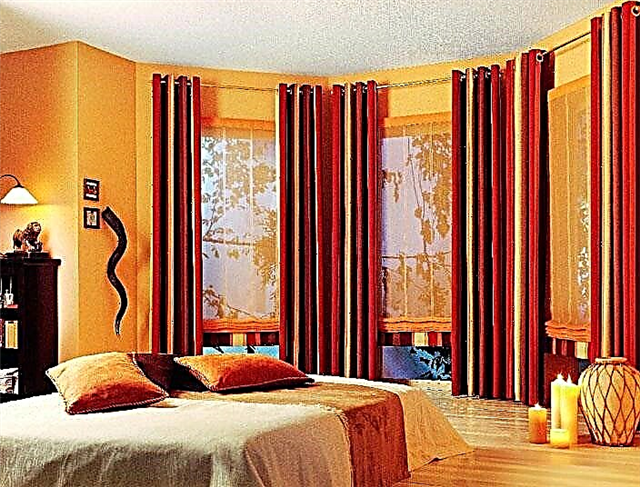
Often, in the interior of the kitchen, the option is used when the windows are hung with Roman curtains in bright colors, and curtains are attached on top.
A stronger and stronger curtain fabric is chosen if it is planned to use tulle in the kitchen with a balcony.
Window with bay window
If necessary, decorate windows with a bay window, several options are allowed. If the ceilings are high - use lambrequins. If low - just shade the interior with textile drapery, festoon or shuttlecock on the curtain.

If the bay window in the kitchen is designed as a niche, then the windows are decorated with Roman curtains or blinds, and at the border of the niche and the room hang curtains fixed on the sides with hooks.
The design of tulle in the kitchen determines the interior aura of the room, its mood. When choosing the type of fabric for the kitchen, it is important to consider the quality characteristics of the textiles, as well as the overall style orientation of the room. Subject to all design recommendations, a comfortable and cozy interior is created.
Options for Tulle Curtains for the Kitchen
Tulle has a patterned or mesh structure, it is smooth and patterned. There are several options for patterned:
- Organza is made from a mixture of polyester and silk. Gentle and smooth, it is great for decorating the kitchen window, while it does not shrink after washing and creases slightly. There is an organza of various colors - from classic white to acid green. Curtains are matte shiny, with patterns or perforated. Organza does not conceal sunlight, but gently passes it through itself, so that a warm glow appears in the kitchen. It is recommended to wash such a tulle manually.

- Kisei. A unique variety, representing a lot of thin threads. The birthplace of such curtains is India, where the curtains were first made from nettles, and then their cotton. Top threads are connected by special weaving. There is a muslin with lurex, beads, sequins, beads. Before washing, the kitten is simply removed from the window and tied in several places with a tape or tied in a knot. Kissa does not need ironing.
- Veil. The basis of fabric production is plain weave. They make fabric from cotton, wool or linen, so this tulle is 100% environmentally friendly. Outwardly, the veil is similar to organza, but differs in a more delicate and matte structure.The veil is universal, harmoniously fits into the design of any interior. Among the shortcomings, the need for special care is noted — washing alone will not be enough.
- Grid. This type of tulle was named for its external similarity to the fishing net. Distinguish a simple grid, with embroidery, with cells of a rectangular shape. Such curtains do not sag, keep a fresh and attractive look for a long time. The grid tolerates washing well, dries quickly. Curtains look interesting both on their own and with thicker curtains. This combination is easy to decorate on your own, for example, embroidery or garters.
When is a long or short tulle suitable?
The long one is great for a window with a balcony door. The fabric will change the interior of any room: it will hide the balcony door, provide easy access, mask the unevenness of the walls. Tulle creates the effect of weightlessness, visually enlarges a small kitchen. 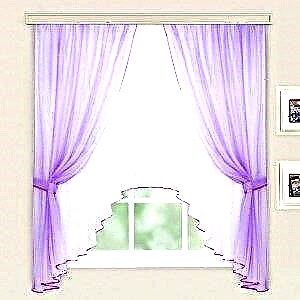
It is recommended that the distance between the curtains and the floor be at least 5-6 cm. This is practical because the curtains will not touch the floor and retain their appearance for longer. Moreover, curtains in the floor visually raise the ceilings. If you want to give the kitchen a luxurious look, the bottom of the tulle is laid on the floor, leaving 10-15 cm free. From the point of view of practicality, this is not rational, but it looks spectacular in classic interiors.
Short tulle for the kitchen - a solution for small windows. Such curtains do not overload the space, look cozy in the styles of Provence, country, retro. The compact tulle is easier to clean and less prone to contamination during cooking. Miniature curtains are indispensable in kitchens with windows to the north side.
Important! So that the tulle does not become gray and faded, it must be washed often. Before washing, the curtains are shaken off dust and soaked for 2 hours in warm water with a soapy solution. After rinsing with clean water, hanged for drying, without squeezing or twisting. When the tulle becomes a little wet, they hang it on the ledge, where it will be smoothed out.
Modern and classic design solutions, how to fit tulle into the interior
Tulle is versatile. It looks spectacular in the styles of Art Nouveau, vintage, Scandy, Provence. How to choose a tulle for a certain interior style:
- To decorate the kitchen, Provence uses a translucent organza of white, pink, blue, peach flowers. Emphasize the individuality of the kitchen embroidery in the form of flowers or angels, light satin ribbons, beads or beads, bows and garters. Short tulle curtains look especially beautiful.
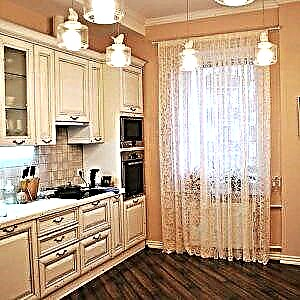
- In the oriental style, bright muslin curtains are used. Primary colors - blue, green, brown, red. Two-curtain design is popular at once. For this, a double-row ceiling cornice is installed.
- The elegance of classic cuisine Emphasizes the traditional tulle to the floor, complemented by more dense curtains with garter. In the classic, white, beige, golden, wood color is welcome.
- For vintage interior the kitchen uses an arch-shaped tulle arch. The arch is great for small windows. It gives the space an elegant and extraordinary look.
- In the country style, tulle mesh is used. On the one hand, it is practical and convenient, on the other - more than ever it symbolizes the simplicity of village life, which underlies the country style. Common colors: beige, olive, brick, shade ocher.
- A monophonic veil with floral ornaments harmoniously fits into the theme of the Art Nouveau style. For example, long green creepers or imitation of a brick wall.
- For cuisine in an unusual direction of art deco or fusion a tulle that combines a veil and cotton fabrics is suitable.
- For retro interiors use vibrant short curtains with many pleats. Apply tulle of red, blue or green colors.
Important! Particular attention is paid to the color of the curtains. If tulle is used as a bright accent, curtains of violet, golden, and burgundy colors are acquired. If this is just an addition to the interior, choose more gentle and calm tones. Curtains with a vertical strip visually enlarge the kitchen, and a small print brings a homely and warm atmosphere to the interior.
How to make the right choice
They prepare food in the kitchen, wash dishes, and gather every day for dinner and breakfast. It is important that the tulle is practical, not deformed under the influence of moisture and other external factors. When choosing a tulle in the kitchen, it is important to follow a few rules:
- Consider the size of the window. For large balconies, curtains on the floor are suitable, for miniature ones - light curtains-cafes.
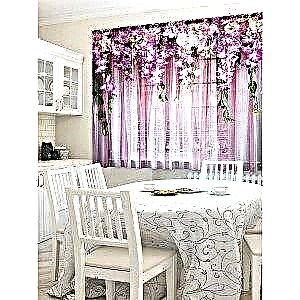
- If tulle is hung as an addition to more dense curtains, the choice is stopped on an organza or veil of pastel shades.
- The darker the room, the brighter the curtains should be.
- When decorating styles, Provence, country or vintage use tulle with additional decoration - embroidery or weaving of ribbons.
- If there are animals or small children in the house, it is not recommended to hang up a kitten or net.
- A profitable option is to purchase ready-made curtains and tulle for the kitchen. So you can save time and effort.
How to hang and fasten a tulle
How the curtains are attached to the cornice depends on how convenient the curtains are in operation. There are various mounting options. The most popular of them: Velcro, rings, hooks, eyelets and loops. Velcro is suitable for the lightest fabrics, they will not stand a dense mesh or muslin.
Eyelets are rings made of wood or plastic that serve as the frame for the opening in the curtain. Eyelets are great for classic luxury interiors. Hinges, rings and hooks are traditional ways of attaching curtains, which are simple and concise. According to the installation method, the following designs are distinguished:
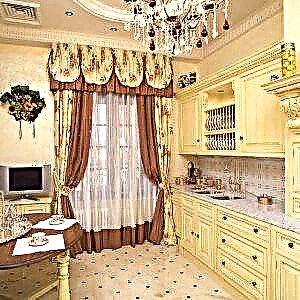
- Ceiling cornice is one of the most affordable and simple options. The cornice weighs little, with the help of self-tapping screws it is attached to the ceiling. It can be of any length and shape. Complete with a cornice are hooks that are fixed to the fabric and inserted into the cornice itself. Tulle glides easily on the ceiling, which is practical and convenient.
- The telescopic curtain rod is great for small windows and light curtains. For fastening use wide rings or eyelets. It is recommended to purchase a cornice made of steel or plastic.
- The rod fits into classic interiors, has an interesting appearance in the form of a bar. There are wooden, plastic, aluminum options. Draperies fasten using rings.
Conclusion
When choosing a tulle for a window in the kitchen, attention is paid to the size of the window, the style of the interior, and personal preferences. The kitchen tulle should be practical and beautiful, its purpose is not only protection from sunlight, but also interior decoration.
For low ceilings, compact curtain-cafe is chosen, for high - long curtains on the floor. Original look organza and veil, decorated with bows, or curtains-muslin with beads. A convenient option for attaching curtains is a ceiling cornice. It is easy to install on its own, it weighs little and is affordable.





